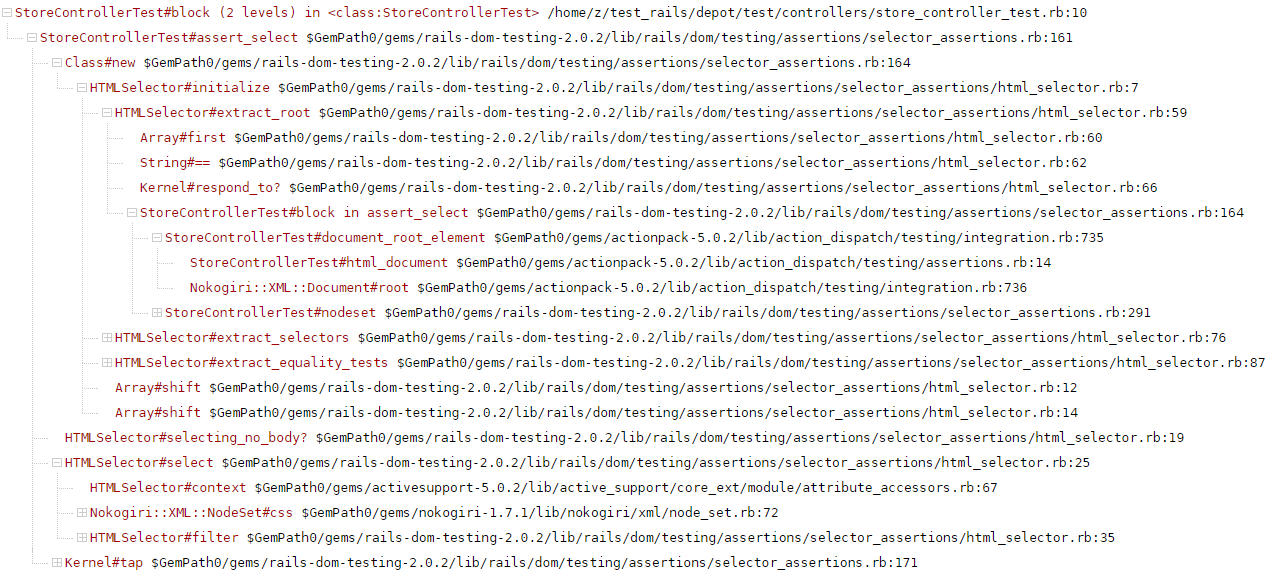Functional Testing of Controllers
对于controller的功能性测试,可以这样写(摘自IntegrationTest里的注释)
class UserFlowsTest < ActionDispatch::IntegrationTest
test "login and browse site" do
# login via https
https!
get "/login"
assert_response :success
post "/login", params: { username: users(:david).username, password: users(:david).password }
follow_redirect!
assert_equal '/welcome', path
assert_equal 'Welcome david!', flash[:notice]
https!(false)
get "/articles/all"
assert_response :success
assert_select 'h1', 'Articles'
end
end这里的assert_response是这样定义的,它只是简单地将assertion转发给@response
module ActionDispatch
module Assertions
# A small suite of assertions that test responses from \Rails applications.
module ResponseAssertions
RESPONSE_PREDICATES = { # :nodoc:
success: :successful?,
missing: :not_found?,
redirect: :redirection?,
error: :server_error?,
}
# Asserts that the response is one of the following types:
#
# * :success - Status code was in the 200-299 range
# * :redirect - Status code was in the 300-399 range
# * :missing - Status code was 404
# * :error - Status code was in the 500-599 range
#
# You can also pass an explicit status number like assert_response(501)
# or its symbolic equivalent assert_response(:not_implemented).
# See Rack::Utils::SYMBOL_TO_STATUS_CODE for a full list.
#
# # Asserts that the response was a redirection
# assert_response :redirect
#
# # Asserts that the response code was status code 401 (unauthorized)
# assert_response 401
def assert_response(type, message = nil)
message ||= generate_response_message(type)
if RESPONSE_PREDICATES.keys.include?(type)
assert @response.send(RESPONSE_PREDICATES[type]), message
else
assert_equal AssertionResponse.new(type).code, @response.response_code, message
end
end之所以能对response做assert,是因为ActionDispatch::IntegrationTest完成一轮请求响应后,有保存@response
def process(method, path, params: nil, headers: nil, env: nil, xhr: false, as: nil)
# ......
session = Rack::Test::Session.new(_mock_session)
session.request(build_full_uri(path, request_env), request_env)
@request_count += 1
@request = ActionDispatch::Request.new(session.last_request.env)
response = _mock_session.last_response
@response = ActionDispatch::TestResponse.from_response(response)
@response.request = @request
@html_document = nil
@url_options = nil
@controller = @request.controller_instance
response.status
end这里包装response的ActionDispatch::TestResponse其实只是简单包装,与RESPONSE_PREDICATES无关
module ActionDispatch
class TestResponse < Response
def self.from_response(response)
new response.status, response.headers, response.body
end
def initialize(*) # :nodoc:
super
@response_parser = RequestEncoder.parser(content_type)
end
# Was the response successful?
alias_method :success?, :successful?
# Was the URL not found?
alias_method :missing?, :not_found?
# Was there a server-side error?
alias_method :error?, :server_error?
def parsed_body
@parsed_body ||= @response_parser.call(body)
end
end
endRESPONSE_PREDICATES所用的方法是Rack本来就提供的
module Rack
class Response
module Helpers
def invalid?; status < 100 || status >= 600; end
def informational?; status >= 100 && status < 200; end
def successful?; status >= 200 && status < 300; end
def redirection?; status >= 300 && status < 400; end
def client_error?; status >= 400 && status < 500; end
def server_error?; status >= 500 && status < 600; end
def ok?; status == 200; end
def created?; status == 201; end
def accepted?; status == 202; end
def no_content?; status == 204; end
def moved_permanently?; status == 301; end
def bad_request?; status == 400; end
def unauthorized?; status == 401; end
def forbidden?; status == 403; end
def not_found?; status == 404; end
def method_not_allowed?; status == 405; end
def precondition_failed?; status == 412; end
def unprocessable?; status == 422; end
def redirect?; [301, 302, 303, 307, 308].include? status; end
end
include Helpers
end
end至于assert_select,使用的是nokogiri来抽取dom来检验
如果进行trace的话
binding.trace_tree(html: true, tmp: ['rails', 'assert_select.html']) do
assert_select '.price', /\$[,\d]+\.\d\d/
end可得调用栈如下
大概流程如下

assert_select会根据所传参数来建立一个HTMLSelector,这个HTMLSelector所要select的页面是document_root_element
def assert_select(*args, &block)
@selected ||= nil
selector = HTMLSelector.new(args, @selected) { nodeset document_root_element }
if selector.selecting_no_body?
assert true
return
end
selector.select.tap do |matches|
assert_size_match!(matches.size, selector.tests,
selector.css_selector, selector.message)
nest_selection(matches, &block) if block_given? && !matches.empty?
end
end这个document_root_element实际上也是从response的body取出html,并用nokogiri包装(解析)出的root元素
#actionpack-5.0.2/lib/action_dispatch/testing/integration.rb
def document_root_element
html_document.root
endhtml_document如下
module ActionDispatch
module Assertions
autoload :ResponseAssertions, 'action_dispatch/testing/assertions/response'
autoload :RoutingAssertions, 'action_dispatch/testing/assertions/routing'
extend ActiveSupport::Concern
include ResponseAssertions
include RoutingAssertions
include Rails::Dom::Testing::Assertions
def html_document
@html_document ||= if @response.content_type.to_s =~ /xml\z/
Nokogiri::XML::Document.parse(@response.body)
else
Nokogiri::HTML::Document.parse(@response.body)
end
end
end
end